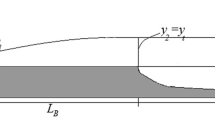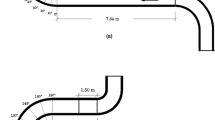Abstract
The bed elevation of the stilling basins is most often located below the river bed in order to provide the required tail water depth. Both basins located in alignment with the erodible bed or below it are studied. To this end, the scoured hole dimensions under various circumstances and the sediment transport process within the scour hole were thoroughly examined. Results revealed that the upstream slopes of the dimensionless scour profiles are approximately identical at different times. According to the results, the basin located below the erodible bed was of a greater maximum scour depth and a lower scour depth at the beginning of the erodible bed. Moreover, a simple generalized equation correlating the temporal development of the maximum scour depth and the scour depth at the beginning of the erodible bed at equilibrium time was derived for the USBR Type I basin aligned with or below the erodible bed.











Similar content being viewed by others
Notes
United States Bureau of Reclamation.
Saint Anthony Falls.
Abbreviations
- W :
-
Channel width
- d 50 :
-
Median grain size
- F d :
-
The densimetric Froude number (\(\frac{{V_{2} }}{{\sqrt {{\text{g}}^{{\prime }} {\text{d}}_{50} } }}\))
- F r :
-
Upstream Froude number (\(\frac{Q}{{By_{1} \sqrt {gy_{1} } }}\))
- \(Fr_{2}\) :
-
Downstream Froude number (\(\frac{{V_{2} }}{{\sqrt {g y_{2} } }}\))
- g :
-
The gravitational acceleration
- g′:
-
\(= \frac{g\Delta \rho }{\rho }\)
- h e :
-
The difference in elevation between the bottom of the basin and the erodible bed level
- L c :
-
The length of the chute channel
- L B :
-
The length of the basin
- L s :
-
The length of the sediment bed
- Q :
-
The flow rate
- Re :
-
Reynolds number = \(\frac{{ \rho V_{2} y_{2} }}{\mu }\)
- t :
-
Time of the scouring
- t * :
-
Time required to reach the maximum scour depth equal to z*
- T :
-
The non-dimensional time of scouring (\(\sqrt {\frac{\Delta \rho }{\rho }gd_{50} } \frac{t}{{ y_{2} }}\))
- V 2 :
-
The velocity of the flow at the end of stilling basin
- y 1 :
-
The initial depth of the jump
- y 2 :
-
The sequent water depth of hydraulic jump
- y t :
-
The tail water depth
- z * :
-
Half the spillway height
- zs :
-
The height of the sedimentary bed
- z 0 :
-
The scour depth at the beginning of the sedimentary bed
- z m :
-
The maximum scour depth at any time
- ρ :
-
Density of the fluid
- ρ s :
-
Density of the sediment
- Δρ :
-
The difference of density between bed material and water (\(= \rho_{s} - \rho\))
- β :
-
The slop of LE basin gravel part
- β 1 :
-
The upstream slop of scoured hole
- β 2 :
-
The downstream slop of scoured hole
- μ :
-
The dynamic viscosity of water
- σ :
-
Standard deviation of sediment
- \(\varphi_{{z_{m} }}\) :
-
The increment percentages of the maximum scour depth for the LE standard basin compared to the SE standard basin
- \(\varphi_{{z_{0} }}\) :
-
The decrement (\({{\upvarphi }}_{{z_{0} }} )\) percentages of the scour depth at the beginning of the erodible bed for the LE standard basin compared to the SE standard basin
References
Kim Y, Choi G, Park H and Byeon S 2015 Hydraulic jump and energy dissipation with sluice gate. Water (Switzerland) 7: 5115–5133. https://doi.org/10.3390/w7095115
Peterka A J (1984) Hydraulic design of stilling basins and energy dissipators. USBR, Denver, CO, A Water Resources Technical Publication, Eng. Monograph 25, 222 pages
Blaisdell F W (1959) The SAF stilling basin: a structure to dissipate the destructive energy in high-velocity flow from spillways. Agriculture Handbook No 156, US Dept of Agriculture, Agricultural Research Service, Washington, DC
Ahmad N (1953) Mechanism of erosion below hydraulic works. Proceedings: Minnesota International Hydraulic Convention, ASCE, Minneapolis, USA. p. 133–143
Farhoudi J (1979) Scaling relationships for local scour downstream of stilling basins. PhD Thesis, University of Southampton , UK, Southampton University
Altinbilek H D (1972) Similarity laws for local scour with special emphasis on vertical circular pipe in oscillatory flow. Hydraulic Research and Its Impact on the Enviroment
Altinbilek H D. and Okyay S (1973) Localized scour in a horizontal sand bed under vertical jets. Proceedings of the 15th IAHR Congress on Research and Practice in the Water Environment, Istanbul, Turkey, p. 99–106
Altinbilek H Dogan Y (1973) Localized scour at the downstream of outlet structures. Proceedings of the 11th Congress of Large Dams, Madrid, Spain. p. 105–121
Rouse H (1940) Criteria for similarity in the transportation of sediment. Proceedings of the 1st Hydraulic Conference, University of Iowa Studies in Engineering, State University of Iowa. p. 33–49
Farhoudi J and Smith K V H 1985 Local scour profiles downstream of hydraulic jump. Journal of Hydraulic Research 23: 343–358. https://doi.org/10.1080/00221688509499344
Breusers H N C (1966) Conformity and time scale in two-dimensional local scour. Proc., Symp. on Model and Prototype Conformity, Hydr. Res. Lab, Poona, India. p. 1–8
Laursen E M (1952) Observations on the nature of scour. Proceedings of 5th Hydrauric Conference., University of Iowa. Bulletin, 34: 179–197
Dargahi B 2003 Scour development downstream of a spillway. Journal of Hydraulic Research 41: 417–426. https://doi.org/10.1080/00221680309499986
Oliveto G 2012 Local scouring downstream of a spillway with an apron. Proceedings of the ICE-Water Management 166: 254–261. https://doi.org/10.1680/wama.11.00101
Farhoudi J and Shayan H K (2014) Investigation on local scour downstream of adverse stilling basins. Ain Shams Engineering Journal, Faculty of Engineering, Ain Shams University. 5: 361–375. https://doi.org/10.1016/j.asej.2014.01.002
Zahed E, Farhoudi J and Javan M (2011) Similarity of scour evolution downstream of stilling basin with an end sill. NEW ASPECTS of FLUID MECHANICS, HEAT TRANSFER and ENVIRONMENT, 45–49
Hassan N M K N and Narayanan R 1985 Local Scour Downstream of an Apron. Journal of Hydraulic Engineering 111: 1371–1385. https://doi.org/10.1061/(ASCE)0733-9429(1985)111:11(1371)
Hojjati S H and Zarrati A R 2021 Numerical study of scouring downstream of a stilling basin. Springer, Environmental Fluid Mechanics, pp 1–18
Farhoudi J, Hosseini S M and Sedghi-Asl M 2010 Application of neuro-fuzzy model to estimate the characteristics of local scour downstream of stilling basins. Journal of Hydroinformatics 12: 201–211. https://doi.org/10.2166/hydro.2009.069
Juon R and Hager W H (2000) Flip bucket without and with deflectors. Journal of Hydraulic Engineering, American Society of Civil Engineers. 126: 837–845
Schwalt M and Hager W H (1992) Die Strahlbox [The jetbox]. Schweizer Ingenieur Und Architekt, 547–549
Haghnazar H and Saneie M (2019) Impacts of pit distance and location on river sand mining management. Modeling Earth Systems and Environment, Springer. 5: 1463–1472
Heller V 2011 Scale effects in physical hydraulic engineering models. Journal of Hydraulic Research 49: 293–306. https://doi.org/10.1080/00221686.2011.578914
Sangsefidi Y, Mehraein M and Ghodsian M (2018) Experimental study on flow over in-reservoir arced labyrinth weirs. Flow Measurement and Instrumentation, Elsevier. 59: 215–224
Sangsefidi Y, Torabi M and Tavakol-Davani H (2020) Discussion on “Laboratory investigation of the discharge coefficient of flow in arced labyrinth weirs with triangular plans” by Monjezi et al.(2018). Flow Measurement and Instrumentation, 72: 101709
Funding
The authors declare that no specific funding was received for this work.
Author information
Authors and Affiliations
Corresponding author
Rights and permissions
About this article
Cite this article
HOJJATI, S.H., ZARRATI, A.R. & DEHNAVI, M.N. Experimental study of scouring downstream of USBR Type I stilling basin aligned with or below the erodible bed. Sādhanā 47, 272 (2022). https://doi.org/10.1007/s12046-022-02037-4
Received:
Revised:
Accepted:
Published:
DOI: https://doi.org/10.1007/s12046-022-02037-4




